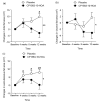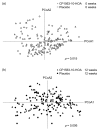Daily Intake of Paraprobiotic Lactobacillus amylovorus CP1563 Improves Pre-Obese Conditions and Affects the Gut Microbial Community in Healthy Pre-Obese Subjects: A Double-Blind, Randomized, Placebo-Controlled Study
- PMID: 32098338
- PMCID: PMC7074956
- DOI: 10.3390/microorganisms8020304
Daily Intake of Paraprobiotic Lactobacillus amylovorus CP1563 Improves Pre-Obese Conditions and Affects the Gut Microbial Community in Healthy Pre-Obese Subjects: A Double-Blind, Randomized, Placebo-Controlled Study
Abstract
Despite the fact that gut microbiota is closely associated with obesity, few studies have focused on the influences of paraprobiotics as food ingredients on both obesity prevention and the gut microbial community. In this study, we evaluated the effects of fragmented Lactobacillus amylovorus CP1563 (CP1563) as a paraprobiotic for obesity prevention and investigated its effects on the gut microbial community in pre-obese subjects. One hundred sixty-nine healthy subjects with a body mass index from 25.0 to 29.9 kg/m2 ingested beverages with or without the fragmented CP1563 containing 10-hydroxyoctadecanoic acid (10-HOA) for 12 weeks. The changes in abdominal, total, visceral, and subcutaneous fatty areas were significantly lower in the CP1563-10-HOA group than in the placebo group at 12 weeks. Furthermore, 16S rRNA gene sequencing of fecal DNA revealed that the changes in the abundances of the genera Roseburia and Lachnospiraceae;g were significantly greater in the CP1563-10-HOA group than in the placebo group, and the changes in the abundances of the genus Collinsella was significantly smaller in the CP1563-10HOA group than in the placebo group. Our results showed that continuous ingestion of the fragmented CP1563 containing 10-HOA reduced abdominal body fat and affected the gut microbial community in pre-obese healthy subjects. Our findings may contribute to the understanding of the relationship between the anti-obesity effect of paraprobiotics and gut microbiota.
Keywords: 10-hydroxyoctadecanoic acid; Lactobacillus amylovorus CP1563; butyrate-producing bacteria; clinical trial; gut microbiota; obesity; paraprobiotics.
Conflict of interest statement
T.S., D.S., S.Y., Y.A., H.S., T.H., and Y.N. are employees of Asahi Quality and Innovations, Ltd., which is related to Asahi Group Holdings, Ltd. The other authors declare that the research was conducted in the absence of any financial relationships that could be constructed as potential conflicts of interest.
Figures




Similar articles
-
Effect of fragmented Lactobacillus amylovorus CP1563 on lipid metabolism in overweight and mildly obese individuals: a randomized controlled trial.Microb Ecol Health Dis. 2016 May 23;27:30312. doi: 10.3402/mehd.v27.30312. eCollection 2016. Microb Ecol Health Dis. 2016. PMID: 27221805 Free PMC article.
-
Fragmented Lactic Acid Bacterial Cells Activate Peroxisome Proliferator-Activated Receptors and Ameliorate Dyslipidemia in Obese Mice.J Agric Food Chem. 2016 Mar 30;64(12):2549-59. doi: 10.1021/acs.jafc.5b05827. Epub 2016 Mar 17. J Agric Food Chem. 2016. PMID: 26927959
-
Regulatory effect of paraprobiotic Lactobacillus gasseri CP2305 on gut environment and function.Microb Ecol Health Dis. 2016 Mar 14;27:30259. doi: 10.3402/mehd.v27.30259. eCollection 2016. Microb Ecol Health Dis. 2016. PMID: 26979643 Free PMC article.
-
Influence of whole-wheat consumption on fecal microbial community structure of obese diabetic mice.PeerJ. 2016 Feb 15;4:e1702. doi: 10.7717/peerj.1702. eCollection 2016. PeerJ. 2016. PMID: 26925326 Free PMC article.
-
Protocol for the Gut Bugs Trial: a randomised double-blind placebo-controlled trial of gut microbiome transfer for the treatment of obesity in adolescents.BMJ Open. 2019 Apr 20;9(4):e026174. doi: 10.1136/bmjopen-2018-026174. BMJ Open. 2019. PMID: 31005929 Free PMC article. Clinical Trial.
Cited by
-
Heterologous expression and antimicrobial potential of class II bacteriocins.Gut Microbes. 2024 Jan-Dec;16(1):2369338. doi: 10.1080/19490976.2024.2369338. Epub 2024 Jun 20. Gut Microbes. 2024. PMID: 38899682 Free PMC article.
-
Complete genome sequence of functional probiotic candidate Lactobacillus amylovorus CACC736.J Anim Sci Technol. 2023 Mar;65(2):473-477. doi: 10.5187/jast.2022.e85. Epub 2023 Mar 31. J Anim Sci Technol. 2023. PMID: 37093924 Free PMC article.
-
Postbiotics against Obesity: Perception and Overview Based on Pre-Clinical and Clinical Studies.Int J Mol Sci. 2023 Mar 29;24(7):6414. doi: 10.3390/ijms24076414. Int J Mol Sci. 2023. PMID: 37047387 Free PMC article. Review.
-
Could paraprobiotics be a safer alternative to probiotics for managing cancer chemotherapy-induced gastrointestinal toxicities?Braz J Med Biol Res. 2023 Jan 16;55:e12522. doi: 10.1590/1414-431X2022e12522. eCollection 2023. Braz J Med Biol Res. 2023. PMID: 36651453 Free PMC article. Review.
-
The Biotics Family: Current Knowledge and Future Perspectives in Metabolic Diseases.Life (Basel). 2022 Aug 19;12(8):1263. doi: 10.3390/life12081263. Life (Basel). 2022. PMID: 36013442 Free PMC article. Review.
References
Grants and funding
LinkOut - more resources
Full Text Sources

